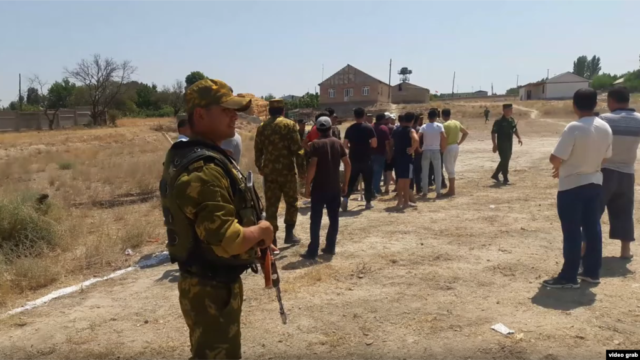
Will Moscow Intervene to Prevent Explosion on Kyrgyz-Tajik Border?
Publication: Eurasia Daily Monitor Volume: 17 Issue: 10
By:

Tensions along the border between Kyrgyzstan and Tajikistan are increasing, but apparently neither country has the political will to address the issues involved in resolving their territorial disputes. In this situation, and to avoid an explosion, the Shanghai Cooperation Organization (SCO—headed mainly by China and Russia) or the Moscow-led Collective Security Treaty Organization (CSTO) should intervene, Irina Dzhorbenidze argues in an article for Rosbalt. She points out that both Central Asian republics are members of these regional groups and that both organizations have among their stated purposes the goal of resolving border disputes. In this situation, she makes the (nonetheless unusual) proposal that they become involved. And if her suggestion were to be accepted, it could introduce dramatic changes to the region (Rosbalt, January 23, 2020).
“If Bishkek and Dushanbe are not in a position to resolve the [border] problem on a bilateral basis,” Dzhorbenidze says, “then why should assistance not be able to come from outside, from the SCO, one of the tasks of which is the resolution of border conflicts, or from the CSTO.” As of now, she continues, “neither of these organizations has stirred” to tackle the challenge even though what is now happening along this border is, “at a minimum,” a threat to “the security of the Central Asian region.” “What are they waiting for? A very large bloodletting?” The likelihood of that is only increasing, the commentator warns (Rosbalt, January 23, 2020).
Kyrgyzstan and Tajikistan possess a common border of 976 kilometers. But only 504 kilometers of this shared frontier has so far been delimited and demarcated, Dzhorbenidze notes. Over the past year, there have been 14 clashes between the two peoples. In the deadliest of these, last September, 4 were killed and 25 were wounded. Nothing quite as deadly erupted there in the last three weeks, but only because whole villages have fled their homes and taken refuge in neighboring settlements. Moreover, it appears that at least several of the clashes that did take place in January 2020 were provoked by the co-ethnics of those who were earlier forced to move (Rosbalt, January 23, 2020; Tajikta.tj [1], [2], March 14, 2019).
The two governments and many analysts blame all these problems on legacies of the Soviet past, but that is only one part of the story, the Rosbalt analyst continues. After all, other Central Asian countries whose borders were also drawn by the Soviets, including Kazakhstan and Uzbekistan, have been able to reach agreements and prevent similar bloodshed (Rosbalt, January 23, 2020).
Why have Kyrgyzstan and Tajikistan not managed the same feat? The reasons are relatively straightforward, Dzhorbenidze writes. These are the two poorest countries in the region. They survive largely by trading in contraband from China and drugs from Afghanistan. And like these illegal traffickers, Islamist groups have an interest in keeping the borders in turmoil so they can spread their influence. Moreover, both of these countries have exclaves (ethnic regions entirely surrounded by the territory of the neighboring country), and have forces within them who believe they can use border tensions either to weaken the current governments or force them to give up plans to join Moscow-led groups like the Eurasian Economic Union (EEU).
Perhaps not surprisingly and at the urging of outsiders (Nezavisimaya Gazeta, July 21, 2019), both Bishkek and Dushanbe have fallen for the idea that the quickest solution is a territorial swap, with each country giving up some piece of land to acquire another, of higher importance to it. That sounds tempting, Dzhorbenidze says; but it is deceptively so. On the one hand, those drawing the new proposed demarcations have paid little attention to the local people, who are now protesting as they find out that their land is about to be shifted, forcing the national governments to deny that is what they are planning. And on the other hand, those likely to benefit and those expected to lose from such land swaps are not the same people, ensuring that tensions will continue (Rosbalt, January 23, 2020).
And so the two governments are now in a difficult and dangerous crossroads: they have signaled they want a deal but have openly promised not to proceed unless everyone agrees. And this precarious arrangement gives those opposed to a border accord every reason to engage in more violence to prevent it. Some in both capitals are even talking about military patrols along the border—which is unlikely to contribute much to stability and good neighborly feelings (Rosbalt, January 23, 2020).
In short, Dzhorbenidze contends, “the problem with this border has been drawn into a very tight knot, and unraveling it will require very strong political will” not only from both sides but from all the organs of state security and interior ministries. That does not exist at present, and outsiders should consider becoming involved, she asserts. Otherwise a major clash lies just ahead, one with the potential to destabilize not just Kyrgyzstan and Tajikistan but the other countries of the region and their neighbors, including the Russian Federation and China.
Her logic is compelling, but Moscow has been exceedingly reluctant to move in this direction given all the red flags it would raise. Now, however, the situation in this remote part of Eurasia may have become so dire that even the Russian government might find it no longer has a choice but to step in.



